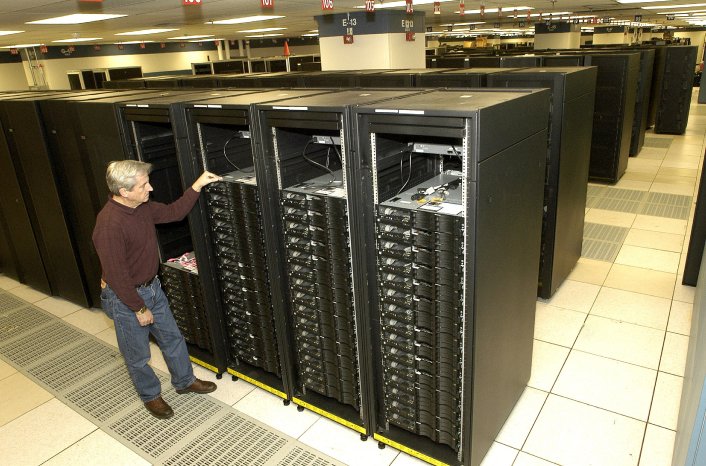- Roadrunner will primarily be used to ensure the safety and reliability of the nation's nuclear weapons stockpile. It will also be used for research into astronomy, energy, human genome science and climate change.
- Roadrunner is the world's first hybrid supercomputer. In a first-of-a-kind design, the Cell Broadband Engine® -- originally designed for video game platforms such as the Sony Playstation 3® -- will work in conjunction with x86 processors from AMD®.
- Made from Commercial Parts. In total, Roadrunner connects 6,948 dual-core AMD Opteron® chips (on IBM Model LS21 blade servers) as well as 12,960 Cell engines (on IBM Model QS22 blade servers). The Roadrunner system has 80 terabytes of memory, and is housed in 288 refrigerator-sized, IBM BladeCenter® racks occupying 6,000 square feet. Its 10,000 connections - both Infiniband and Gigabit Ethernet -- require 57 miles of fiber optic cable. Roadrunner weighs 500,000 lbs. Companies that contributed components and technology include; Emcore, Flextronics, Mellanox and Voltaire.
- Custom Configuration. Two IBM QS22 blade servers and one IBM LS21 blade server are combined into a specialized "tri-blade" configuration for Roadrunner. The machine is composed of a total of 3,456 tri-blades built in IBM's Rochester, Minn. plant. Standard processing (e.g., file system I/O) is handled by the Opteron processors. Mathematically and CPU-intensive elements are directed to the Cell processors. Each tri-blade unit can run at 400 billion operations per second (400 Gigaflops).
- The machine was built, tested and benchmarked in IBM's Poughkeepsie, N.Y. plant, home of the ASCI series of supercomputers the company built for the US government in the late 1990s. IBM's site in Rochester, Minn. constructed the specialized tri-blade servers. Software development was led by IBM engineers in Austin, Texas and by researchers in IBM's Yorktown Heights, N.Y. research lab. Roadrunner will be loaded onto 21 tractor trailer trucks later this summer when it is delivered to Los Alamos National Lab in New Mexico.
- Roadrunner operates on open-source Linux software from Red Hat.
- Energy Miser. Compared to most traditional supercomputer designs, Roadrunner's hybrid format sips power (3.9 megawatts) and delivers world-leading efficiency - 376 million calculations per watt. IBM expects Roadrunner to place among the top energy-efficient systems later in June when the official "Green 500" list of supercomputers is issued.
- IBM is developing new software to make Cell-powered hybrid computing broadly accessible. Roadrunner's massive software effort targets commercial applications for hybrid supercomputing. With corporate and academic partners, IBM is developing an open-source ecosystem that will bring hybrid supercomputing to financial services, energy exploration and medical imaging industries among others.
Applications for Cell-based hybrid supercomputing include: calculating cause and effect in capital markets in real-time, supercomputers in financial services can instantly predict the ripple effect of a stock market change throughout the markets. In medicine, complex 3-D renderings of tissues and bone structures will happen in real-time, as patients are being examined.
How fast is a petaflop?
Roadrunner operates at speeds exceeding one petaflop -- one thousand trillion calculations per second -- or one million billion calculations per second; or one quadrillion calculations per second.
- Lots of laptops. That's roughly equivalent to the combined computing power of 100,000 of today's fastest laptop computers. You would need a stack of laptops 1.5 miles high to equal Roadrunner's performance.
- It would take the entire population of the earth, -- about six billion - each of us working a handheld calculator at the rate of one second per calculation, more than 46 years to do what Roadrunner can do in one day.
- In the past 10 years, supercomputer power has increased about 1,000 times. Today, just three of Roadrunner's 3,456 Tri-blade units have the same power as the 1998 fastest computer. A complex physics calculation that will take Roadrunner one week to complete, would have taken the 1998 machine 20 years to finish - it would be half done today! If it were possible for cars to improve their gas mileage over the past decade at the same rate that supercomputers have improved their cost and efficiency, we'd be getting 200,000 miles to the gallon today.

